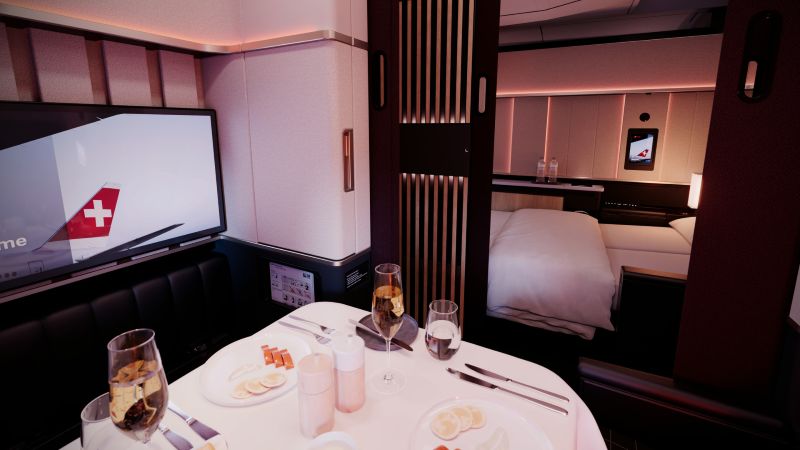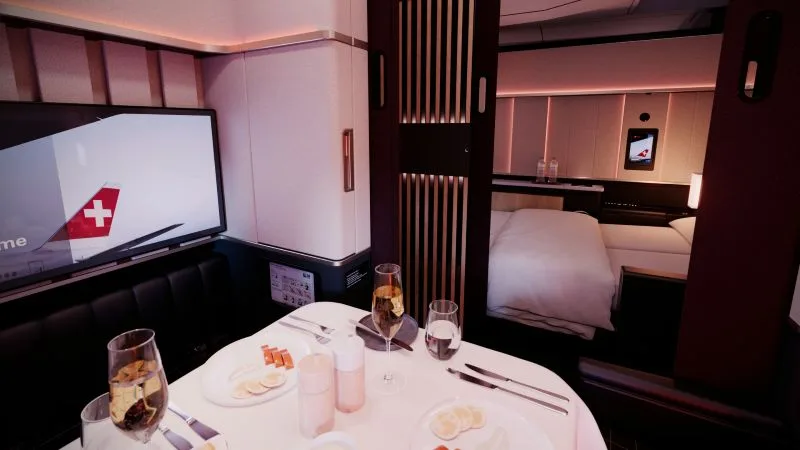Published on
August 23, 2025

Switzerland’s Luxury Leap: The First Grand Suite Redefining High-End Air Travel
Observers from across the aviation sector suggested that the unveiling of the First Grand Suite in Switzerland was being regarded not merely as another cabin update, but as a moment that could redefine the entire meaning of luxury in the skies. They explained that the development was interpreted as a benchmark-shifting move, one capable of raising global standards for privacy, exclusivity, and personalized comfort.
Commentators insisted that what was once considered a rare indulgence—such as ample space, privacy, or bespoke service—was now evolving into an expectation for those traveling in First Class. Analysts argued that this change would not remain confined to Switzerland; rather, it was expected to ripple outward across the aviation industry.
They noted that other airlines would likely feel compelled to reconsider or refine their premium cabins if they wished to remain competitive. By doing so, the entire market could experience a shift toward customization and exclusivity, making them central pillars of long-haul travel.
Particular attention was drawn to the effect this would have on long-haul routes departing from Switzerland. Experts explained that such flights were poised to gain new prestige in the global market, drawing attention from premium travelers who valued both comfort and status.
It was also suggested that the introduction of the Grand Suite could blur the lines between business travel and luxury leisure travel. Those traveling for professional reasons were seen as increasingly placing comfort and autonomy on the same level as productivity, while affluent leisure travelers were also looking for personalized experiences that matched their lifestyle expectations.
In conclusion, industry voices pointed out that this innovation might reshape the very definition of premium travel, situating innovation, freedom of choice, and emotional engagement at the heart of the passenger journey.
A Loft in the Sky: Redefining Passenger Experience
Specialists remarked that the Grand Suite was envisioned not merely as a seat redesign but as a “loft in the sky”. According to them, the atmosphere it created was intended to resemble a private residence, one that allowed travelers to feel as if they were at home, despite being thousands of feet above the ground.
They highlighted how the design was said to embody the precision and refinement associated with Switzerland, embedding cultural values directly into the air travel experience. This was not perceived as a superficial enhancement but as a deliberate attempt to elevate travel into an immersive experience.
Commentators added that the Grand Suite was meant to evoke emotional connections, rather than merely providing physical comfort. In their analysis, the goal was to create journeys that passengers could feel rather than simply endure.
Enhancing Privacy and Customization
Reports emphasized that privacy and personalization were at the very core of the Grand Suite’s concept. It was explained that passengers would no longer be limited by the predefined settings of standard cabins. Instead, they would be able to adjust their environment according to their preferences.
Travelers were said to have the choice of resting in peace, working productively, or simply enjoying complete seclusion. Experts argued that this flexibility reflected a larger global shift in luxury travel, where exclusivity and bespoke services were no longer optional but non-negotiable expectations.
Industry observers pointed out that this development marked an evolution in premium aviation standards. Comfort and additional amenities had once been sufficient to attract premium customers, but the new era was increasingly defined by autonomy and customization.
This perspective was linked to broader luxury market trends worldwide, where individuality and personal choice were regarded as essential. Analysts explained that the Grand Suite aligned directly with those expectations, ensuring that passengers felt not only served but empowered.
Personal Space at 35,000 Feet
Analysts stated that the Grand Suite introduced a groundbreaking approach to cabin layout. They explained that it merged two private suites and the aisle into a single, enclosed space, creating a private enclave at cruising altitude.
Commentators suggested that this unique arrangement allowed passengers to repurpose the space as needed. For some, it could serve as a bedroom offering full privacy; for others, it might function as a workplace equipped for productivity; and for yet others, it could be adapted as a meeting space, even while flying at 35,000 feet.
Observers agreed that this design directly responded to the modern traveler’s demand for multi-functional environments. They argued that today’s passengers were increasingly global citizens, balancing professional commitments and personal comfort, often within the same journey.
It was concluded that the Grand Suite blurred the traditional boundaries between home, office, and travel, offering a flexible solution that could adapt seamlessly to each passenger’s needs.
Introduction Timeline and Aircraft Deployment
Reports confirmed that the rollout of the Grand Suite had been strategically planned. Observers revealed that it was set to debut in early 2026, marking the beginning of its introduction into long-haul aviation.
It was explained that the first aircraft to feature the Grand Suite would include the Airbus A350s and the refurbished Airbus A330s, both of which would operate from Switzerland. Analysts emphasized that the choice of these aircraft was not coincidental, as they were widely used on some of the country’s most prestigious long-haul routes.
They also noted that later phases of the rollout would extend the design to the Boeing 777s, ensuring that the innovation became a consistent feature across multiple flagship aircraft.
Industry experts remarked that the phased rollout was a deliberate strategy. It was believed to allow airlines to:
- Gather authentic passenger feedback.
- Adjust services and refine details.
- Fine-tune the operation before introducing it more broadly.
Observers concluded that this approach demonstrated a careful understanding of the risks and complexities of implementing radical innovations in global aviation.
Expanding Luxury Options in the Air
Commentators explained that the Grand Suite was only one part of a broader expansion of luxury offerings. They pointed out that alongside it, passengers would also find access to other exclusive seating options, such as the Single Suite and the Middle Suite Plus.
The Single Suite was described as being ideal for travelers who valued seclusion near the window, while the Middle Suite Plus was designed to allow two passengers to sit together while still enjoying privacy.
Industry observers noted that this tiered arrangement reflected an understanding of diverse passenger preferences. Some valued total privacy, while others preferred a balance between intimacy and exclusivity.
They further explained that these varied options would likely be particularly attractive to:
- Business travelers who required adaptable spaces.
- High-net-worth individuals searching for distinctive experiences.
- Leisure passengers looking for personalized luxury.
It was concluded that by offering multiple levels of exclusivity, airlines could strengthen the role of First Class as a defining feature in the global aviation market.
A Vision for the Future of Premium Travel
Industry voices indicated that the introduction of the Grand Suite was not just a new product but part of a future-focused vision. They explained that it represented a decisive turn toward personalization, exclusivity, and meaningful engagement in air travel.
Experts suggested that this innovation would likely encourage global competitors to re-examine their First Class concepts, potentially sparking a new era of refinement. It was observed that privacy, space, and comfort were no longer luxuries—they were becoming requirements.
They added that the Grand Suite directly addressed what modern passengers were seeking: environments that mirrored their private lives, even while traveling internationally.
With its 2026 launch date approaching, it was predicted that travelers would soon experience unprecedented levels of luxury, setting a standard that could influence global air travel for decades.
The Broader Significance for Global Aviation
Observers insisted that the unveiling of the Grand Suite in Switzerland symbolized more than a cabin upgrade; it was being recognized as an emblem of transformation.
They stated that the global travel industry was steadily shifting toward experience-driven journeys, where luxury extended beyond fine dining or reclining seats. Passengers were said to be purchasing not only a ticket from point A to point B, but also a tailored journey that reflected their lifestyle and values.
It was suggested that the Grand Suite stood as a symbol of Switzerland’s cultural precision and refinement, capable of influencing industry-wide standards across the globe.
Commentators concluded that this development illustrated the future of aviation, where the focus was no longer just on transportation but on immersion, individuality, and belonging. Travelers were predicted to experience air travel not as a necessity but as an extension of their personal world—a seamless blend of home, office, and sanctuary in the sky.
Source: SWISS







